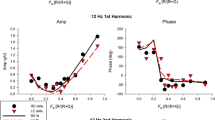Abstract
Protanopic, deuteranopic and tritanopic neutral points were computed by determining the wavelength of light that produced the same quantal-catch ratio in the photopigments as that produced by a broad-band light of specified color temperature (range: 2 800–6 600 K). The Vos-Walraven primaries were used as photopigment absorption spectra that were screened by varying densities of ocular (0.5–2,5 at 400 nm) and macular (0.0–1.0 at 460nm) pigmentation. The computations were carried out in 1 nm steps for the wavelength range of 380 to 720 nm. Most of the empirically determined mean, neutral-point loci in the literature were predicted from these computations to within 1–2 nm when average ocular and macular pigment densities were used. The neutral-point range associated with the extreme values of the prereceptoral screening pigments was up to 25 nm for protanopes and deuteranopes and up to 13 nm for tritanopes.
Access this chapter
Tax calculation will be finalised at checkout
Purchases are for personal use only
Preview
Unable to display preview. Download preview PDF.
Similar content being viewed by others
References
Boettner, E. A. and Wolter, J. R. Transmission of the ocular media. Invest. Ophthalmol 1: 776–783 (1962).
Fischer, F. P., Bouman, M. A. and Doesschate, J. T. A case of tritanopy. Doc. Ophthalmol 5/6: 73–87 (1951).
Hecht, S. and Shlaer, S. The color vision of dichromats. I. Wavelength discrimination, brightness distribution, and color mixture. J. Gen. Physiol. 20: 57–82 (1936).
Hering, E. Uber individuelle Verschiedenheiten des Farbensinnes. [On individual differences in color vision]. Lotos, Naturwissenschaftliche Zeitschrift 6: 142–198 (1885).
Judd, D. B., Plaza, L. and Farnsworth, D. Tritanopia with abnormally heavy ocular pigmentation, J. Opt. Soc. Am. 40: 833–841 (1950).
Pitt, F. H. G. Characteristics of dichromatic vision. Med. Res. Council (London) (1935).
Ruddock, K. H. The effect of age upon colour vision. II. Changes with age in light transmission of the ocular media. Vision Res. 5: 47–58 (1965).
Said, F. S. and Weale, R. A. The variation with age of the spectral transmissivity of the living human crystalline lens. Gerontol. 3: 213–231 (1959).
Schultze, M. Ueber den gelben Fleck der Retina, seinen Einfluss auf normales Sehen and auf Farbenblindheit. Verlag von Max Cohen and Sohn, Bonn (1866).
Sloan, L. L. and Habel, A. Color signal systems for the red-green color blind. An experimental test of the three-color signal system proposed by Judd. J. Opt. Soc. Am. 45: 592–598 (1955).
Stiles, W. S. and Burch, J. M. N.P.L. colour-matching investigation: Final report (1958). Opt. Acta 6: 1–26 (1959).
Verriest, G. The spectral curve of relative luminous efficiency in different age groups of aphakic eyes. Mod. Prob. Ophthalmol 13: 314–317 (1974).
Vos, J. J. Colorimetric and photometric properties of a 2° fundamental observer. Col. Res. Appl. 3: 125–128 (1978).
Walls, G. L. Notes on four tritanopes. Vision Res. 4: 3–16 (1964).
Walls, G. L. Neutral points in 138 protanopes and deuteranopes. J. Opt. Soc. Am. 46: 640–649 (1956).
Walls, G. L. and Mathews, R. W. New means of studying color blindness and normal foveal color vision. University of California Press, Berkeley (1952).
Werner, J. S. Development of scotopic sensitivity and the absorption spectrum of the human ocular media. J. Opt. Soc. Am. 72: 247–258 (1982).
Wright, W. D. The characteristics of tritanopia, J. Opt. Soc. Am. 42: 509–521 (1952).
Wyszecki, G. and Stiles, W. S. Color Science. New York: Wiley, (1982).
Author information
Authors and Affiliations
Editor information
Rights and permissions
Copyright information
© 1984 Dr W. Junk Publishers The Hague, Boston, Lancaster
About this paper
Cite this paper
Kliegl, R., Volbrecht, V.J., Werner, J.S. (1984). Influences of Variation in Lenticular and Macular Pigmentation on Dichromatic Neutral Points. In: Verriest, G. (eds) Colour Vision Deficiencies VII. Documenta Ophthalmologica Proceedings Series, vol 39. Springer, Dordrecht. https://doi.org/10.1007/978-94-009-6551-5_17
Download citation
DOI: https://doi.org/10.1007/978-94-009-6551-5_17
Publisher Name: Springer, Dordrecht
Print ISBN: 978-94-009-6553-9
Online ISBN: 978-94-009-6551-5
eBook Packages: Springer Book Archive




